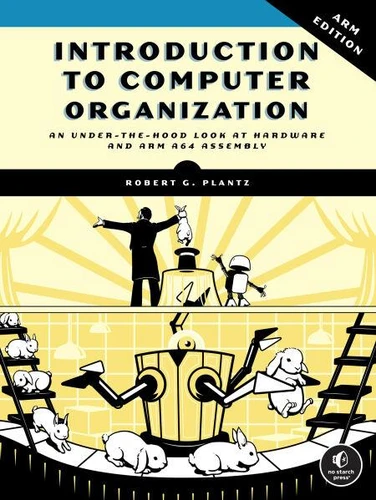Introduction to Computer Organization: ARM Edition
Par :Formats :
Disponible dans votre compte client Decitre ou Furet du Nord dès validation de votre commande. Le format ePub est :
- Compatible avec une lecture sur My Vivlio (smartphone, tablette, ordinateur)
- Compatible avec une lecture sur liseuses Vivlio
- Pour les liseuses autres que Vivlio, vous devez utiliser le logiciel Adobe Digital Edition. Non compatible avec la lecture sur les liseuses Kindle, Remarkable et Sony
 , qui est-ce ?
, qui est-ce ?Notre partenaire de plateforme de lecture numérique où vous retrouverez l'ensemble de vos ebooks gratuitement
Pour en savoir plus sur nos ebooks, consultez notre aide en ligne ici
- Nombre de pages520
- FormatePub
- ISBN978-1-7185-0275-8
- EAN9781718502758
- Date de parution28/01/2025
- Protection num.pas de protection
- Taille23 Mo
- Infos supplémentairesepub
- ÉditeurNo Starch Press
Résumé
See How the Magic Happens Built with ARM A64 Assembly LanguageThe ARM edition of Introduction to Computer Organization will show you how high-level code connects to computer hardware through ARM 64-bit assembly language. You'll learn ARM assembly language from the ground up, and all you'll need is some basic experience with programming. As you grow to understand ARM's 64-bit design (from first principles), you'll develop the skills to write more efficient, optimized code.
Learn the fundamentals: Data storage formats and computer encoding Binary and hexadecimal arithmetic operations Boolean algebra and logic gates Digital circuit design Explore how software and hardware interact: Memory hierarchy, from CPU registers to the cloud CPU architecture and instruction execution ARM 64-bit assembly language programming Get hands-on experience programming the GPIO on Raspberry Pi 3, 4, and 5 in assembly.
Use GNU programming tools to examine code generated from C and C++ by the compiler, write assembly programs from scratch, and use the debugger to visualize execution, inspect registers, and understand machine-level operations. Each chapter includes practical "Your Turn" exercises to reinforce key concepts and build real-world programming skills. Whether you're optimizing code performance, developing embedded systems, or simply curious about how computers execute your programs, this guide provides deep insight into how software and hardware interact to bring programs to life.
Learn the fundamentals: Data storage formats and computer encoding Binary and hexadecimal arithmetic operations Boolean algebra and logic gates Digital circuit design Explore how software and hardware interact: Memory hierarchy, from CPU registers to the cloud CPU architecture and instruction execution ARM 64-bit assembly language programming Get hands-on experience programming the GPIO on Raspberry Pi 3, 4, and 5 in assembly.
Use GNU programming tools to examine code generated from C and C++ by the compiler, write assembly programs from scratch, and use the debugger to visualize execution, inspect registers, and understand machine-level operations. Each chapter includes practical "Your Turn" exercises to reinforce key concepts and build real-world programming skills. Whether you're optimizing code performance, developing embedded systems, or simply curious about how computers execute your programs, this guide provides deep insight into how software and hardware interact to bring programs to life.
See How the Magic Happens Built with ARM A64 Assembly LanguageThe ARM edition of Introduction to Computer Organization will show you how high-level code connects to computer hardware through ARM 64-bit assembly language. You'll learn ARM assembly language from the ground up, and all you'll need is some basic experience with programming. As you grow to understand ARM's 64-bit design (from first principles), you'll develop the skills to write more efficient, optimized code.
Learn the fundamentals: Data storage formats and computer encoding Binary and hexadecimal arithmetic operations Boolean algebra and logic gates Digital circuit design Explore how software and hardware interact: Memory hierarchy, from CPU registers to the cloud CPU architecture and instruction execution ARM 64-bit assembly language programming Get hands-on experience programming the GPIO on Raspberry Pi 3, 4, and 5 in assembly.
Use GNU programming tools to examine code generated from C and C++ by the compiler, write assembly programs from scratch, and use the debugger to visualize execution, inspect registers, and understand machine-level operations. Each chapter includes practical "Your Turn" exercises to reinforce key concepts and build real-world programming skills. Whether you're optimizing code performance, developing embedded systems, or simply curious about how computers execute your programs, this guide provides deep insight into how software and hardware interact to bring programs to life.
Learn the fundamentals: Data storage formats and computer encoding Binary and hexadecimal arithmetic operations Boolean algebra and logic gates Digital circuit design Explore how software and hardware interact: Memory hierarchy, from CPU registers to the cloud CPU architecture and instruction execution ARM 64-bit assembly language programming Get hands-on experience programming the GPIO on Raspberry Pi 3, 4, and 5 in assembly.
Use GNU programming tools to examine code generated from C and C++ by the compiler, write assembly programs from scratch, and use the debugger to visualize execution, inspect registers, and understand machine-level operations. Each chapter includes practical "Your Turn" exercises to reinforce key concepts and build real-world programming skills. Whether you're optimizing code performance, developing embedded systems, or simply curious about how computers execute your programs, this guide provides deep insight into how software and hardware interact to bring programs to life.




